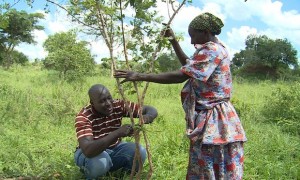
Stephen Tumhaire rakes through the knee-high grass in his field to get rid of fallen tree branches that might stop the grass from growing. Sweat shines on his face, and he repeatedly mops it with his palm. In 1972, Tumhaire’s grandfather moved from the west of Uganda to the central Nakasongola district, a once sparsely populated area now made up of small farms created when farmers started dividing land among their children.
With increasing rural-urban migration in the area, demand for charcoal grew in nearby towns and villages, and this accelerated a vicious cycle of deforestation that began with the clearing of land for cultivation. “This place was good before charcoal burning took centre stage. There were very many trees, there was much grass and cows, hence abundant milk,” he says.
Tumhaire lives in Chamkama village in Uganda’s cattle corridor, 140km north of the capital Kampala. He says that in the mid-90s charcoal burning became so lucrative some young men dropped out of school to focus on making the fuel. Now, efforts are under way to use farmers, like Tumhaire, to help revive the trees through a scheme known as farmer managed natural regeneration (FMNR). Farmers encourage regrowth by pruning and protecting existing trees, as well as encouraging new growth from felled tree stumps, sprouting root systems or seeds.
The regrown trees and shrubs improve the soil, prevent erosion and water loss, and increase biodiversity. This can translate into increased crop yields, more timber for firewood and better incomes for farmers.




